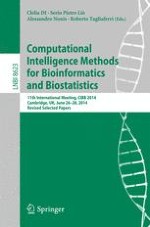2015 | Buch
Computational Intelligence Methods for Bioinformatics and Biostatistics
11th International Meeting, CIBB 2014, Cambridge, UK, June 26-28, 2014, Revised Selected Papers
herausgegeben von: Prof. Clelia DI Serio, Dr. Pietro Liò, Alessandro Nonis, Prof. Roberto Tagliaferri
Verlag: Springer International Publishing
Buchreihe : Lecture Notes in Computer Science
